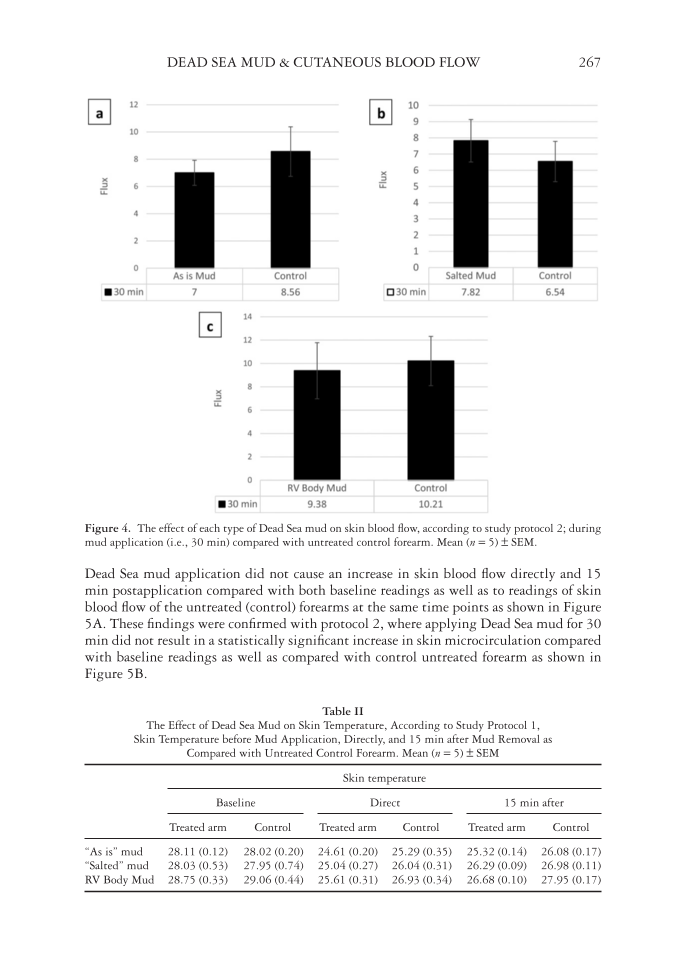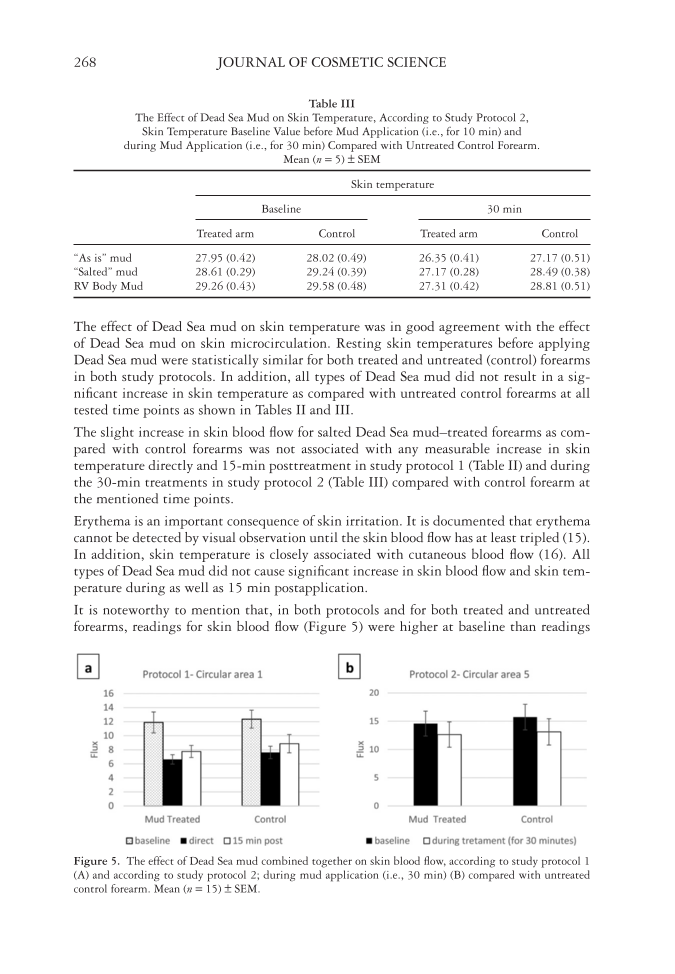DEAD SEA MUD & CUTANEOUS BLOOD FLOW 267 Dead S ea mud application did not cause an increase in skin blood fl ow directly and 15 min postapplication compared with both baseline readings as well as to readings of skin blood fl ow of the untreated (control) forearms at the same time points as shown in Figure 5A. These fi ndings were confi rmed with protocol 2, where applying Dead Sea mud for 30 min did not result in a statistically signifi cant increase in skin microcirculation compared with baseline readings as well as compared with control untreated forearm as shown in Figure 5B. Figur e 4. The effect of each type of Dead Sea mud on skin blood fl ow, according to study protocol 2 during mud application (i.e., 30 min) compared with untreated control forearm. Mean (n = 5) ± SEM. Table II The Effect of Dead Sea Mud on Skin Temperature, According to Study Protocol 1, Skin Temperature before Mud Application, Directly, and 15 min after Mud Removal as Compared with Untreated Control Forearm. Mean (n = 5) ± SEM Skin temperature Baseline Direct 15 min after Treated arm Control Treated arm Control Treated arm Control “As is” mud 28.11 (0.12) 28.02 (0.20) 24.61 (0.20) 25.29 (0.35) 25.32 (0.14) 26.08 (0.17) “Salted” mud 28.03 (0.53) 27.95 (0.74) 25.04 (0.27) 26.04 (0.31) 26.29 (0.09) 26.98 (0.11) RV Body Mud 28.75 (0.33) 29.06 (0.44) 25.61 (0.31) 26.93 (0.34) 26.68 (0.10) 27.95 (0.17)
JOURNAL OF COSMETIC SCIENCE 268 The ef fect of Dead Sea mud on skin temperature was in good agreement with the effect of Dead Sea mud on skin microcirculation. Resting skin temperatures before applying Dead Sea mud were statistically similar for both treated and untreated (control) forearms in both study protocols. In addition, all types of Dead Sea mud did not result in a sig- nifi cant increase in skin temperature as compared with untreated control forearms at all tested time points as shown in Tables II and III. The sl ight increase in skin blood fl ow for salted Dead Sea mud–treated forearms as com- pared with control forearms was not associated with any measurable increase in skin temperature directly and 15-min posttreatment in study protocol 1 (Table II) and during the 30-min treatments in study protocol 2 (Table III) compared with control forearm at the mentioned time points. Erythe ma is an important consequence of skin irritation. It is documented that erythema cannot be detected by visual observation until the skin blood fl ow has at least tripled (15). In addition, skin temperature is closely associated with cutaneous blood fl ow (16). All types of Dead Sea mud did not cause signifi cant increase in skin blood fl ow and skin tem- perature during as well as 15 min postapplication. It is noteworthy to mention that, in both protocols and for both treated and untreated forearms, readings for skin blood fl ow (Figure 5) were higher at baseline than readings Table III The Effect of Dead Sea Mud on Skin Temperature, According to Study Protocol 2, Skin Temperature Baseline Value before Mud Application (i.e., for 10 min) and during Mud Application (i.e., for 30 min) Compared with Untreated Control Forearm. Mean (n = 5) ± SEM Skin temperature Baseline 30 min Treated arm Control Treated arm Control “As is” mud 27.95 (0.42) 28.02 (0.49) 26.35 (0.41) 27.17 (0.51) “Salted” mud 28.61 (0.29) 29.24 (0.39) 27.17 (0.28) 28.49 (0.38) RV Body Mud 29.26 (0.43) 29.58 (0.48) 27.31 (0.42) 28.81 (0.51) Figure 5 . The effect of Dead Sea mud combined together on skin blood fl ow, according to study protocol 1 (A) and according to study protocol 2 during mud application (i.e., 30 min) (B) compared with untreated control forearm. Mean (n = 15) ± SEM.
Purchased for the exclusive use of nofirst nolast (unknown) From: SCC Media Library & Resource Center (library.scconline.org)


















































